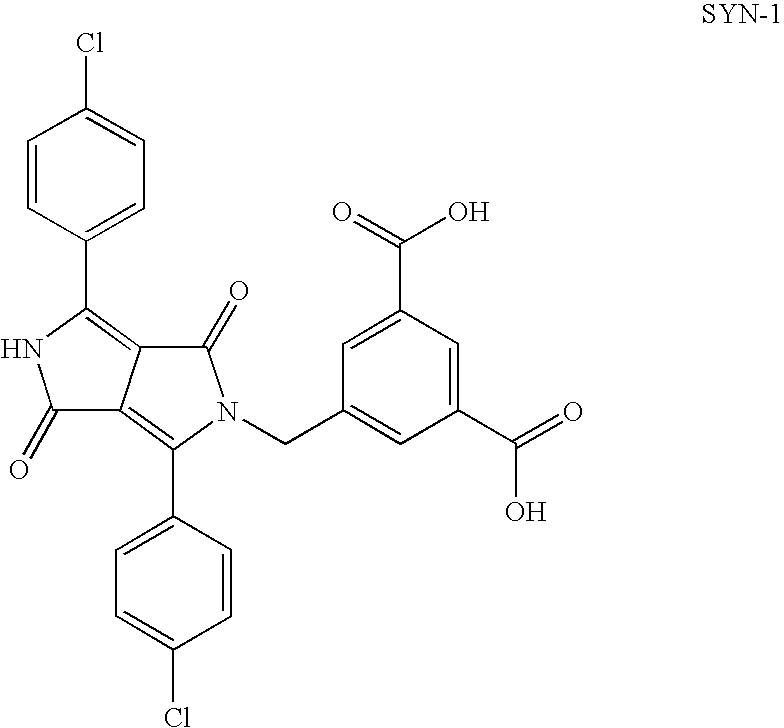Stable non-aqueous inkjet inks
- Summary
- Abstract
- Description
- Claims
- Application Information
AI Technical Summary
Benefits of technology
Problems solved by technology
Method used
Image
Examples
example 1
Example 1
[0222]This example illustrates that the use of polyalkyleneglycol dialkylethers with a molecular weight larger than 250 improves the pigment dispersion quality and stability compared to lower molecular weight polyalkyleneglycol dialkylethers.
Preparation and Evaluation of Inkjet Inks
[0223]All inkjet inks were prepared in the same manner to obtain a composition as described in Table 1 and Table 2, except that the concentration of the dispersion synergist and the type of solvent (the “dispersion solvent”) in the milling mixture were altered. The concentration of the dispersion solvent in the milling mixture was compensated in function of the amount of dispersion synergist.
[0224]A milling mixture with 15 wt % pigment and 15 wt % dispersant was prepared by adding the pigment PB15:4, the polymeric dispersant Solsperse M 39000 and the dispersant synergist Solsperse M 5000 to the dispersion solvent. The milling mixture was then milled during cooling by a NETZSCH™ LABSTAR1 at a 50%...
example 2
[0229]This example illustrates that polyalkyleneglycol dialkylethers with a molecular weight larger than 250 as dispersion solvents in the milling mixture allows a wider choice of ink solvents.
Preparation and Evaluation of Inkjet Inks
[0230]All inkjet inks were prepared in the same manner to obtain a composition as described in Table 5 and Table 6, except that the concentration of the dispersion synergist and the type of solvent (the “dispersion solvent”) in the milling mixture were altered.
[0231]A milling mixture with 15 wt % pigment and 15 wt % dispersant was prepared by adding the pigment PY150 and the polymeric dispersant Solsperse™ 39000 to the dispersion solvent. The milling mixture was then milled during cooling by a NETZSCH™ LABSTAR1 at a 50% volume filling with yttrium-stabilized zirconium oxide-beads of 0.4 mm diameter (“high wear resistant zirconia grinding media” from TOSOH Co.) and a residence time of 45 minutes.
[0232]The comparative non-aqueous inkjet inks COMP-4 to COM...
example 3
Example 3
[0235]This example illustrates a CMYK non-aqueous inkjet ink set suitable for producing decorative laminates with a warm wooden color appearance.
Preparation and Evaluation of Inkjet Inks
[0236]All non-aqueous inkjet inks were prepared in the same manner to obtain a composition as described in Table 8. If a dispersion synergist was present, the concentration of the dispersion solvent in the milling mixture was compensated for by the function of the dispersion synergist.
[0237]A milling mixture with 15 wt % pigment and 15 wt % dispersant was prepared by adding the pigment, the polymeric dispersant Solsperse™ 39000 and, optionally, the dispersant synergist to the dispersion solvent. The milling mixture was then milled during cooling by a NETZSCH™ LABSTAR1 at a 50% volume filling with yttrium-stabilized zirconium oxide-beads of 0.4 mm diameter (“high wear resistant zirconia grinding media” from TOSOH Co.) and a residence time of 45 minutes.
[0238]The cyan, magenta and yellow non-...
PUM
| Property | Measurement | Unit |
|---|---|---|
| Diameter | aaaaa | aaaaa |
| Diameter | aaaaa | aaaaa |
| Nanoscale particle size | aaaaa | aaaaa |
Abstract
Description
Claims
Application Information
 Login to View More
Login to View More - R&D
- Intellectual Property
- Life Sciences
- Materials
- Tech Scout
- Unparalleled Data Quality
- Higher Quality Content
- 60% Fewer Hallucinations
Browse by: Latest US Patents, China's latest patents, Technical Efficacy Thesaurus, Application Domain, Technology Topic, Popular Technical Reports.
© 2025 PatSnap. All rights reserved.Legal|Privacy policy|Modern Slavery Act Transparency Statement|Sitemap|About US| Contact US: help@patsnap.com



